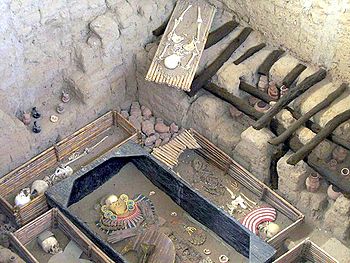The Lord of Sipán (El Señor de Sipán) is the name of a mummy of an elite man found in Sipán by Peruvian archaeologistWalter Alva in 1987. The tomb is in Sipán's Huaca Rajada, an area in Chiclayo.
The Lord of Sipán tomb is a Moche culture site in Peru. Some archaeologists hold it to be one of the most important archaeological discoveries in this region of the world in the last 30 years, as the main tomb was found intact and untouched by thieves.
Sipán is located in the northern part of Peru, close to the coast, in the middle of the Lambayeque Valley, 35 km east of Chiclayo, Peru. Four tombs have been found in Sipán's Huaca Rajada. This was a burial mound, a kind of mausoleum, built by the Moche culture. Its people ruled the northern coast of Peru from around 1 AD to 700 AD.
The town of Sipán, in the Zaña district, is roughly around 20 miles east of the city of Chiclayo and 45–50 miles away from Lambayeque. The site belonged to the Moche (Mochican) culture that mainly worshipped the god called Ai Apaec (Ayapec) as "principal" god or deity.
The clothing of this warrior and ruler suggest he was approximately 1.67 m tall. He probably died within three months of governing. His jewelry and ornaments indicate he was of the highest rank, and include pectoral, necklaces, nose rings, ear rings, helmets, falconry and bracelets. Most were made of gold, silver, copper and semi-precious stones. In his tomb were found more than 400 jewels.
The Lord of Sipán was wearing a precious necklace with beads of gold and silver in the shape of maní (peanuts) represent the tierra (earth). The peanuts symbolized that men came from the land, and that when they die, they return back to the earth; the Moches harvested peanuts for food. The necklace has 10 kernels to the right, which are gold, signifying masculinity and the sun god, while the kernels on the left side are silver, to represent femininity and the moon god.
Below the tomb of the Lord of Sipan, two other tombs were found: that of a priest and of the Old Lord of Sipan. DNA analysis of the remains established that the priest was contemporary with the Lord of Sipan. Artifacts in his tomb are believed to be related to religion: the cup or bowl for the sacrifices, a metal crown adorned with an owl with its wings extended, and other items for worship of the moon.
DNA analysis of remains of the Old Lord of Sipan proved that he was a direct ancestor of the Lord of Sipan. In his tomb were found the remains of a young woman, a likely sacrifice to accompany him to the next life. Also there were sumptuous costumes embroidered with gold and silver.
The Royal Tombs Museum of Sipán houses most of the important artifacts which Dr. Walter Alva Alva found in 1987. He helped found and support construction of the museum, which opened in 2002. The museum is located in the town of Lambayeque, Peru. (which also happens to be in the "state" of Lambayeque) in Peru. The museum was designed to resemble the ancient Moche tombs (with the exception of giant golden figures on the side).
The museum's main attraction is the Lord of Sipan and his entourage, who accompanied him to the afterworld with him. The warriors who were buried with him had amputated feet, as if to prevent their leaving the tomb. The women were dressed in ceremonial clothes. Dogs, llamas, and more than 80 huacos (works of ceramic pottery) were also buried in the tomb.
Wikicredits.


No hay comentarios:
Publicar un comentario